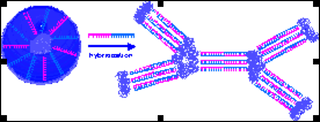The hydrogels above rely on cross-linking by Watson-Crick base pairing.
However, one can also achieve cross-linking by hydrophobic interactions. For
that purpose linear amphiphilic DNA diblock copolymers will be employed with
the hydrophobic polymer units attached to the 5’- and 3’-ends. Moreover, their
molecular parameters will be adjusted so that spherical micelles are formed.
The conversion into hydrogels cross-linked by hydrophobic interactions will
then be achieved by hybridization with sequences that are complementary to the
DNA segments of the two diblock copolymers forcing the hydrophobic polymer
units in opposite directions of the central double helix (Figure below). A similar
strategy was employed by our group to transform spherical micelles into
rod-like DBC aggregates.(Ding K, Alemdaroglu FE, Boersch M, Berger R, Herrmann A, Angew. Chem. Int. Ed.
46 (7): 1172-1175 2007) Disassembly will be
achieved by dehybridization induced e.g. by electrolysis of water at the
electrodes of the microfluidic devices.

DNA hydrogels induced by hydrophobic interactions.
